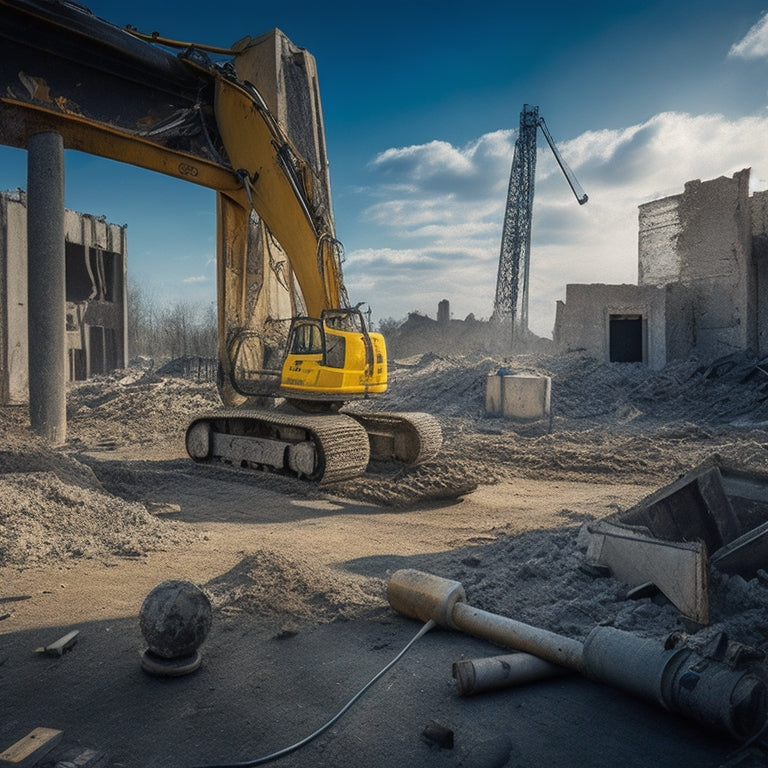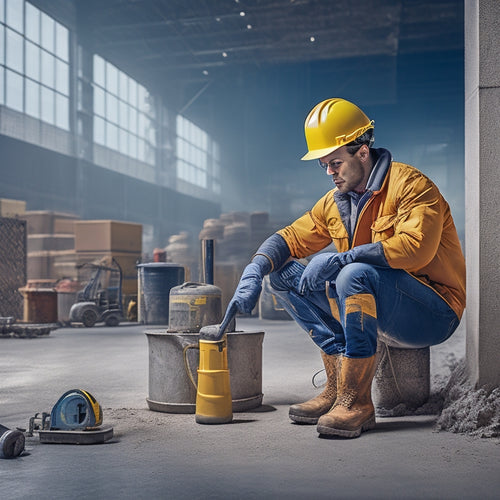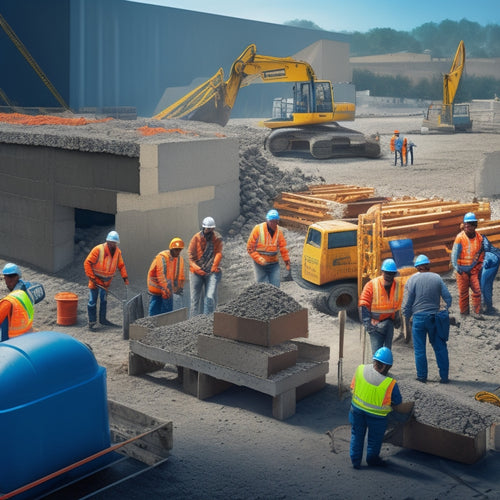
Top Tools for Concrete Demolition Projects
Share
When it comes to concrete demolition projects, you'll need the right tools to get the job done efficiently and safely. You'll want to evaluate heavy-duty demolition hammer drills for thick, reinforced concrete structures, as well as industrial-grade jackhammers and bits for intense force and precision. Electric concrete breakers and chisels can deliver high-impact force, while rotary hammers excel in precision applications. Don't forget about high-torque wrecking bars and tools for targeted demolition, and powerful demolition saw blades for cutting through thick concrete. Now, learn how to choose the best tools for your specific project and get ready to tackle the concrete with confidence.
Key Takeaways
• Heavy-duty demolition hammer drills deliver high-torque impacts ideal for large concrete slabs or walls, requiring safety gear and regular maintenance.
• Industrial-grade jackhammers and bits provide intense force and precision, with bit selection and maintenance crucial for peak performance and reduced downtime.
• Electric concrete breakers and chisels offer high-impact force for speed and efficiency, with weight and power output impacting performance and bit selection.
• Rotary hammers excel in precision applications like demolishing walls, floors, and foundations, with variable speed control and anti-vibration systems enhancing safety and control.
• Hydraulic crushing force and pulverizer attachment options provide immense pressure and versatility for concrete demolition, with force output and pressure control systems critical for efficiency and tool protection.
Heavy-Duty Demolition Hammer Drills
You'll likely reach for heavy-duty demolition hammer drills when tackling thick, heavily reinforced concrete structures that require intense breaking and demolition power. These powerful tools are designed to deliver high-torque impacts, making them ideal for demolition projects that involve breaking up large, dense concrete slabs or walls.
When using heavy-duty demolition hammer drills, it's vital to prioritize demolition safety. Always wear proper personal protective equipment (PPE), including gloves, safety glasses, and a dust mask, to minimize the risk of injury from flying debris and dust inhalation.
Regular equipment maintenance is also important to guarantee peak performance and extend the lifespan of your drill. Check the drill's air filter and lubricate the hammer mechanism regularly to prevent overheating and wear. Additionally, inspect the drill's cord and plug for damage, and replace them if necessary.
High-Torque Wrecking Bars and Tools
When the demolition project requires more precision and control than a heavy-duty demolition hammer drill can provide, you can rely on high-torque wrecking bars and tools to deliver targeted, concentrated force to specific areas of the concrete structure.
These tools are ideal for projects that demand precision, such as removing concrete around pipes or electrical conduits. High-torque wrecking bars and tools are designed to provide maximum force in a compact package, allowing you to tackle tough demolition tasks with ease.
To get the most out of your high-torque wrecking bars and tools, keep the following in mind:
-
Regularly inspect and maintain your wrecking bars to prevent damage and guarantee peak performance.
-
Use torque measurement tools to confirm you're applying the correct amount of force for the job.
-
Choose the right wrecking bar for the task at hand, considering factors like length, material, and handle type.
-
Always wear proper safety gear, including gloves and safety glasses, when operating wrecking bars and tools.
-
Consider using wrecking bars with ergonomic handles to reduce fatigue and improve control.
Electric Concrete Breakers and Chisels
Electric concrete breakers and chisels deliver high-impact force to demolish concrete with speed and efficiency, making them ideal for large-scale demolition projects or applications where precision is not paramount. When choosing an electric concrete breaker, consider the weight, power output, and chisel type.
| Feature | Description |
|---|---|
| Weight | Ranges from 15-40 lbs; heavier breakers provide more force |
| Power Output | Measures in amps or joules; higher output for tougher concrete |
| Chisel Type | Flat, point, or wedge-shaped; choose based on concrete type and desired break pattern |
To get the most out of your electric concrete breaker, master concrete chisel techniques such as maintaining a consistent angle, applying controlled pressure, and using the correct chisel for the job. Regular electric breaker maintenance is also essential, including lubricating moving parts, inspecting cords and connections, and storing the tool properly when not in use. By following these guidelines, you'll be able to efficiently demolish concrete and achieve professional results.
Industrial-Grade Jackhammers and Bits
For heavy-duty demolition projects that require intense force and precision, industrial-grade jackhammers and bits are the tools of choice, delivering unparalleled power and versatility to tackle even the toughest concrete structures. These high-performance tools are designed to withstand the rigors of intense demolition work, providing you with the reliability and efficiency you need to get the job done quickly and effectively.
When it comes to selecting the right jackhammer and bits for your project, here are some key considerations to keep in mind:
-
Choose the right bit type: Select bits that are specifically designed for your specific demolition task, whether it's breaking up concrete, asphalt, or rock.
-
Maintain your jackhammer: Regularly inspect and maintain your jackhammer to prevent wear and tear, and guarantee peak performance.
-
Select bits with the right shank size: Ensure the shank size of your bit matches the chuck size of your jackhammer to prevent damage or breakage.
-
Consider the weight and balance: Opt for jackhammers and bits that provide ideal weight and balance, reducing fatigue and improving control.
-
Invest in high-quality bits: High-quality bits may cost more, but they'll provide better performance, longer lifespan, and reduced downtime.
Rotary Hammers for Heavy Demolition
You'll often find that rotary hammers, with their high-torque motors and pulverizing bits, are better suited for heavy demolition projects that require a more controlled, precision-oriented approach than industrial-grade jackhammers and bits.
These powerful tools excel in applications where precision and finesse are essential, such as demolishing concrete walls, floors, or foundations.
When selecting a rotary hammer for your project, consider key features like variable speed control, anti-vibration systems, and dust-reducing designs. These features enhance your control and comfort while operating the tool, allowing you to focus on the task at hand.
To guarantee rotary hammer safety, always follow the manufacturer's guidelines and take necessary precautions.
Wear protective gear, including gloves, safety glasses, and a dust mask. Additionally, maintain a firm grip on the tool and keep your work area clean and clear of debris.
Powerful Demolition Saw Blades
When selecting a demolition saw blade, you'll want to contemplate the material it's made of, as it directly impacts the blade's durability and cutting performance.
You'll also need to think about the cutting depth capacity you require, as this will determine the size and type of concrete structures you can effectively demolish.
Blade Material Matters
Demolition saw blades made from high-carbon steel consistently outperform their counterparts regarding cutting speed and blade life.
You'll notice a significant difference in cutting efficiency when using high-carbon steel blades, especially in demanding concrete demolition projects. This is because high-carbon steel blades retain their sharpness longer, reducing the need for frequent replacements and allowing you to complete tasks more quickly.
When selecting a demolition saw blade, consider the following key factors:
-
Blade type: Diamond blades, abrasive blades, and carbide-tipped blades each have their strengths and weaknesses. Diamond blades are ideal for cutting through hard materials, while abrasive blades are better suited for softer materials.
-
Tooth configuration: The arrangement of teeth on the blade affects cutting efficiency. A higher tooth count typically results in a faster cut, but may reduce blade life.
-
Coating and surface finish: A blade's coating and surface finish can impact its performance. Look for blades with a rust-resistant coating and a smooth surface finish to reduce friction and heat buildup.
-
Core material: The core material affects the blade's overall strength and durability. A strong core material like high-carbon steel helps to prevent blade breakage.
-
Wet or dry cutting: Determine whether the blade is designed for wet or dry cutting, as this affects its performance and longevity.
Cutting Depth Capacity
With powerful demolition saw blades, the cutting depth capacity is a critical factor to assess, as it directly impacts the blade's ability to efficiently cut through thick concrete slabs and other tough materials.
You'll want to evaluate the blade's maximum cutting depth, which is typically measured in inches or millimeters. This measurement determines the blade's capacity to penetrate and cut through concrete, so it's vital to choose a blade that can handle the thickness of your material.
When selecting a demolition saw blade, you'll also want to evaluate the cutting techniques you'll be using. For example, will you be using a push or pull cutting technique? This will affect the blade's cutting depth capacity and overall performance.
Additionally, you'll want to verify accurate depth measurement to avoid over- or under-cutting, which can lead to reduced blade life or inefficient cutting.
Concrete Crushing and Pulverizing Tools
When you're tackling concrete demolition projects, you'll need tools that can generate immense force to break up and pulverize concrete.
You'll want to contemplate tools that offer hydraulic crushing force, which can be adjusted to suit the specific demands of your project.
Hydraulic Crushing Force
You'll rely on hydraulic crushing force to power concrete crushing and pulverizing tools, which generate immense pressure to break down concrete structures into manageable pieces.
The hydraulic system's crushing efficiency is vital in concrete demolition projects, as it directly affects the speed and effectiveness of the process.
Optimizing force distribution is key to achieving maximum crushing efficiency. Here are some essential considerations for hydraulic crushing force:
-
Force output: Confirm the hydraulic system can generate the required force to crush concrete structures of varying thicknesses and strengths.
-
Pressure control: Implement a pressure control system to regulate the hydraulic pressure and prevent damage to the tool or equipment.
-
Flow rate: Optimize the hydraulic flow rate to achieve the desired crushing speed and efficiency.
-
Tool design: Select tools with optimized geometries and materials to maximize crushing force and minimize wear.
-
Maintenance: Regularly inspect and maintain the hydraulic system to prevent leaks, contamination, and other issues that can reduce crushing efficiency.
Pulverizer Attachment Options
Your concrete demolition project's success relies on selecting the right pulverizer attachment options, which can greatly enhance the capabilities of your concrete crushing and pulverizing tools.
With various pulverizer types available, it's crucial to choose the one that best suits your project's requirements. You can opt for a fixed pulverizer, which provides high crushing forces and is ideal for processing large concrete structures. Alternatively, a rotating pulverizer is perfect for secondary demolition and recycling applications, offering increased versatility and precision.
When selecting a pulverizer attachment, consider the pulverizer benefits it offers. Look for attachments with high torque and crushing force, as they can efficiently process concrete debris. Additionally, consider the attachment's weight, as lighter options can reduce fuel consumption and improve overall machine performance.
Some pulverizers also feature interchangeable teeth and jaw sets, allowing you to adapt to different demolition tasks. By choosing the right pulverizer attachment option, you can streamline your concrete demolition process, reduce costs, and increase productivity.
Specialized Demolition Attachments Needed
What specific tasks do you need to accomplish on your concrete demolition project that require specialized attachments?
Depending on the scope of your project, you may need to crush, break, or dismantle concrete structures, which demands the right demolition attachment types.
When selecting specialized demolition attachments, consider the following essential factors:
-
Demolition grapples: for handling and processing large concrete debris
-
Concrete crushers: for reducing concrete into smaller, manageable pieces
-
Hydraulic breakers: for breaking up concrete floors, walls, or foundations
-
Demolition pulverizers: for pulverizing concrete into recyclable materials
-
Sorting grapples: for separating and sorting concrete debris by size and material
It's vital to guarantee attachment compatibility considerations, such as the weight and flow rate of your carrier machine, to optimize the performance of your chosen attachment.
Frequently Asked Questions
What Safety Gear Is Required for Concrete Demolition Projects?
When you're involved in concrete demolition projects, you must prioritize your safety above all else.
You'll need to follow strict safety regulations, which require you to wear personal protective equipment (PPE) at all times. This includes hard hats, safety glasses, earplugs, dust masks, steel-toed boots, and gloves.
Don't forget to wear long sleeves, pants, and a dust-resistant jacket to prevent skin exposure.
How Do I Choose the Right Tool for a Specific Demolition Task?
Did you know that 75% of demolition accidents occur due to incorrect tool usage?
When tackling a demolition task, you'll want to choose the right tool for the job. Start by analyzing the task at hand, considering factors like material type, size, and structural integrity.
Employ tool selection strategies like categorizing tools by functionality and weighing the pros and cons of each option.
Through thorough demolition task analysis, you'll guarantee the most efficient and safe outcome.
Can I Rent Concrete Demolition Tools Instead of Buying Them?
When considering equipment for a project, you're weighing the option of renting concrete demolition tools instead of buying them.
This approach makes sense, especially for infrequent or one-time uses.
Conduct a cost comparison to determine the break-even point.
Rental benefits include reduced upfront costs, minimized storage needs, and access to specialized tools without long-term commitment.
What Are the Noise Regulations for Concrete Demolition in Residential Areas?
When you're planning a concrete demolition project in a residential area, you'll need to contemplate noise regulations.
You'll likely require residential permits, which often come with specific noise restrictions.
To minimize disturbance, you'll want to implement noise barriers, such as acoustic screens or sound curtains, to reduce decibel levels.
Make sure to check local ordinances for specific guidelines on acceptable noise levels and permitted work hours to avoid fines or project delays.
How Do I Properly Dispose of Concrete Debris After Demolition?
As you navigate the complex landscape of concrete demolition, it's essential to properly dispose of the resulting debris, just as a skilled sailor charts a course through treacherous waters.
You'll want to explore concrete recycling options, which can salvage up to 90% of the material.
Effective debris management involves segregating materials, crushing on-site, and transporting to recycling facilities.
Don't let concrete waste sink your project – stay afloat with a well-planned disposal strategy.
Conclusion
As you wrap up your concrete demolition project, you've got the right arsenal at your disposal. From heavy-duty hammer drills to specialized attachments, these top tools have helped you dismantle even the toughest structures.
Like a master sculptor, you've chiseled away at the concrete, revealing the hidden framework beneath. Your toolbox has been your trusted companion, providing the precision and power to tackle the most demanding tasks.
With these tools, you've conquered the concrete jungle, leaving behind a landscape of rubble and possibility.
Related Posts
-

10 Best Tools for Sealed Concrete Flooring on Budget
When starting on a sealed concrete flooring project on a budget, you'll need to prioritize essential tools without sa...
-

5 Best Tools for Stamping Concrete Walls
When it comes to stamping concrete walls, you'll need a range of specialized tools to achieve the desired texture and...
-

7 Best Tools for Concrete Block Construction
You'll need a solid foundation, precise cutting, and seamless finishing to guarantee your concrete block construction...


